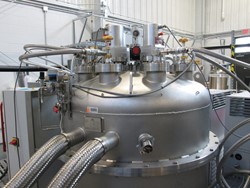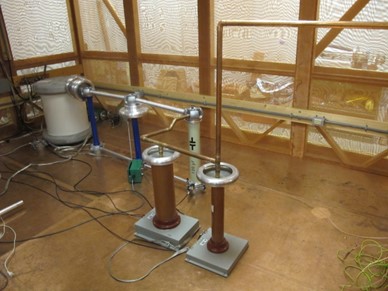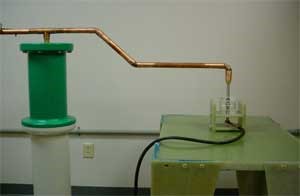High Temperature Superconductivity and Dielectrics Program
High temperature superconductors - these materials with no resistance to the flow of electricity have the potential to revolutionize electric power technologies. The Center for Advanced Power Systems (CAPS) is leading the way to widespread use of superconductors.

Superconductivity research promises significant advancements in the electric energy field. These advancements will help produce, transmit and use electricity at much higher capacity, with greater stability, increased efficiency and at lower costs.
The Center for Advanced Power Systems (CAPS) brings unique resources to the research and development community through its state of the art characterization facilities essential for advancing superconductor technologies. Since opening the Superconductivity Laboratory in 2001, CAPS has become an integral part of many related public and private research programs.
At CAPS, new technology-based businesses, university researchers and others in the electric energy field can perform a wide range of testing and demonstrations in our superconductor and cryogenics laboratory.

The CAPS testing facilities integrate state-of-the-art power "hardware-in-the-loop" test environment and cryogenic test environment for superconducting system components. CAPS expert scientists and staff specialize in the area of AC loss measurement and quench stability of superconducting materials. Our facility also offers a high-voltage Dielectrics Testing Laboratory for investigation and testing dielectric characteristics of superconducting power system components at high voltages. We can test partial discharge activity at up to 100 kV AC or breakdown at 100 kV AC, 140 kV DC or lightning/switching impulses of up to 120 kV peak. All these tests can be performed under extreme cryogenic temperatures (as low as 30 Kelvin).
One of our primary goals is to partner in the development of technologies that will meet the energy needs of the future. Toward that goal, CAPS collaborates with other national laboratories, universities and private industry. CAPS research teams conduct work and investigate AC loss characteristics of superconducting wires, coils, and power system components at a range of cryogenic temperatures, magnetic fields and transport current.
Laboratory Capabilities and Technical Specifications
High Temperature Superconductors AC Loss and Stability Measurements
CAPS has a total AC loss measurement facility suitable for characterizing HTS materials, for example with regard to stability and quench propagation, under a wide range of parameters. A key feature of the CAPS’ facility is the ability to conduct variable temperature measurements in the range of 25° K to 100° K.
AC Magnet: A novel design consisting of several layers of helical coils creates a magnetic field perpendicular to the axis of the magnet and highly uniform over 150° mm. The magnet allows measurements on long samples and allows for rotation of the sample in magnetic field to vary the field angle. The magnetic field strength can be varied between zero and 200° mT and the frequency can be varied between DC and 5° kHz.
Cryostats: The cryostats for AC loss and Stability/Quench propagation measurements are equipped with custom designed current leads and liquid nitrogen wells to intercept the heat from current leads. The liquid nitrogen jackets cryostats are cooled with cryocoolers to enable experiments under a variety of cooling environments ranging from purely conductive cooling in vacuum to experiments a variety of cryogen baths.
Power supplies: CAPS’ facility has several DC and AC power supplies to run transport current through the conductor and provide power to the AC magnets. The power supplies are suitable for variable frequency experiments.
Ranges of various parameters available for Total AC Loss and Stability Measurements:
- Transport Current: up to 650A DC and 500 A AC
- Magnetic field: DC up to 250 mT, AC between up to 200 mT (depending on frequency)
- Frequency: DC – 10 kHz
- Temperature: 30 – 100 K
- Field orientation: 0-90°
- Cooling environment: conduction cooling, helium gas, or liquid cryogens In addition to the specialized equipment listed above, CAPS has a wide selection of multimeters, temperature controllers, lock-in amplifiers, signal generators, etc. for experimentation and data collection.
Dielectric Research Laboratory
The following major equipment has been installed in the Dielectric Research Laboratory:
- An Impulse Generator with a peak impulse voltage of 140 kV and energy of 250 J. The voltage waveform is the standardized 1.2/50 ms impulse which is typical for representing a lightning strike
- A DC generator with 140 kV peak voltage, 11.2 mA current and a ripple voltage of less than 3%
- A 100 kV, 50 mA, 5 kVA transformer for partial discharge measurements
- An optical cryostat with 6 inch quartz windows. The operational pressure range is from 10 -8 Torr to atmospheric pressure and the temperature ranges from 30 K to 293 K. The high voltage feed-through is rated at 150 kV and 7 A.
- A cryocooler with a cold head power of 300 W;
- A tand measurement system, consisting of a single phase voltage regulated transformer rated at 100 kV, 150 kVA and a tand measurement bridge
- A mass spectrometer with a mass range of 1 to 200 AMU;
- For optical studies a lens, a beam-splitter and photomultiplier tubes with a spectral range of interest of 160 nm to 450 nm

This existing equipment is ideally suited for studying and characterization of a variety of dielectric materials of interest in the manufacture of HTS devices such as transformers, motors, cables and switching devices, at cryogenic temperatures. Another research aspect will be on gaining an understanding of mechanisms leading to the failure of dielectrics under a variety of physical conditions that are imposed on devices. Simultaneous electrical and optical measurements would add to the body of knowledge in this emerging area. Special emphasis will be placed on fast transients which can place devices under arduous conditions during their operation.
